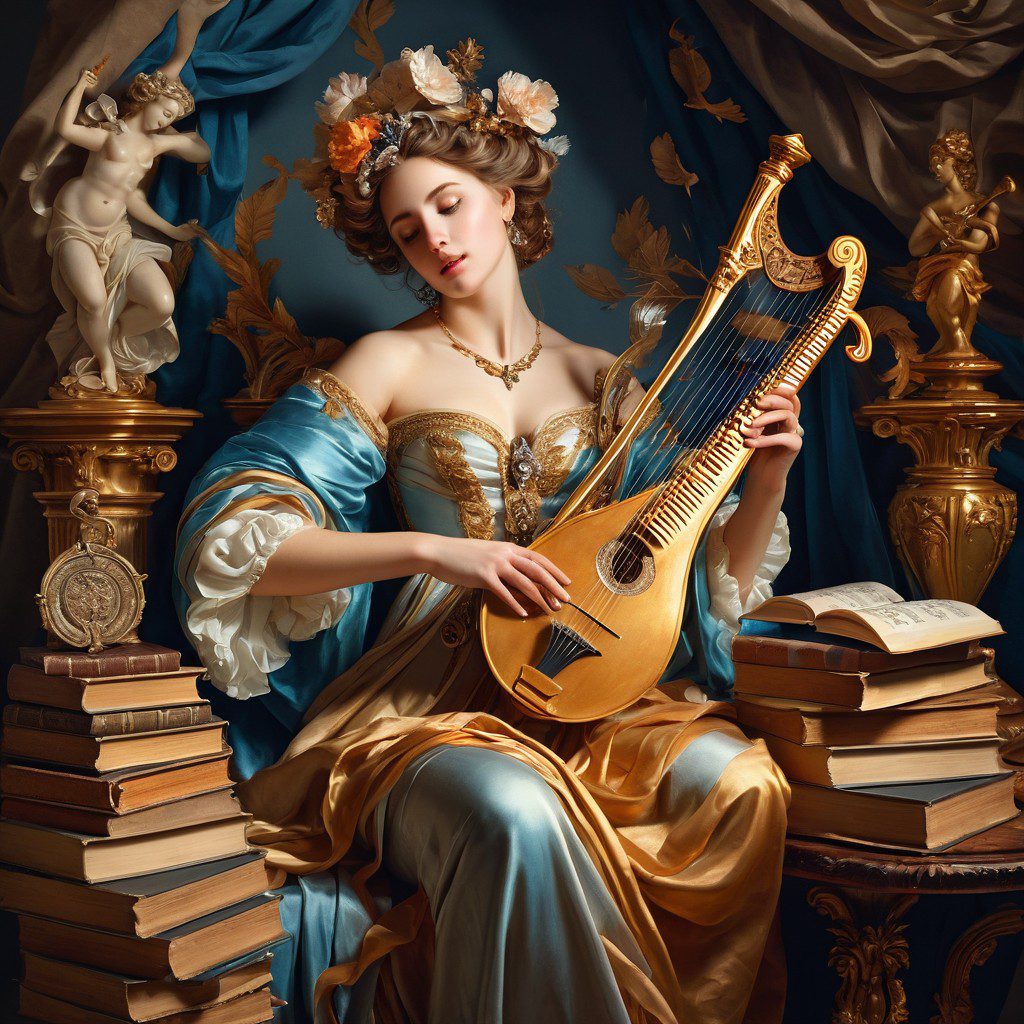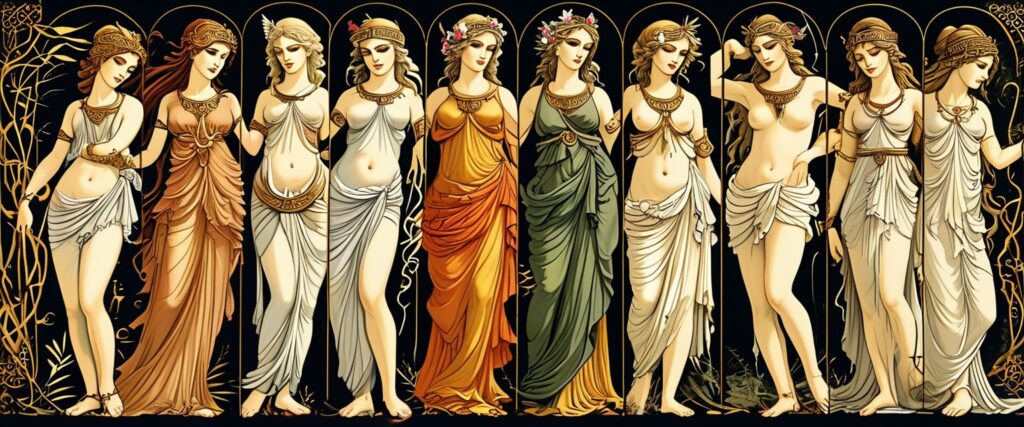The Muses: Divine Inspiration of the Arts and Sciences

The Muses are among the most beloved and revered figures of Greek mythology. These nine goddesses, daughters of Zeus and Mnemosyne (the Titaness of memory), are the personification of the arts, sciences, and knowledge. They were believed to inspire poets, musicians, philosophers, and artists, guiding them in their creative and intellectual pursuits. The Muses represent the Greek cultural belief in the divine origins of inspiration and the idea that art and knowledge were gifts bestowed by the gods. For centuries, they have continued to inspire artists and thinkers, both in classical times and in modern media.
Origins and Mythological Background
The Muses originated from the union of Zeus, the king of the gods, and Mnemosyne, the goddess of memory. According to myth, the Muses were born after Zeus lay with Mnemosyne for nine nights, resulting in the birth of nine daughters. Their connection to Mnemosyne emphasizes the importance of memory in the creation of art, poetry, and storytelling—fields in which the past plays a crucial role.
Originally, the Muses were worshipped primarily in Thrace and Mount Helicon in Boeotia, where they were associated with springs and rivers, linking them to the natural world and its rhythms. Over time, they became patrons of specific disciplines, each Muse representing a different field of the arts or sciences. These areas of influence often overlap, reflecting the interconnectedness of creativity and knowledge in Greek culture.
The Nine Muses and Their Domains

As the mythology surrounding them developed, the Muses were assigned individual roles, each presiding over a particular artistic or intellectual sphere. They were often invoked at the beginning of literary or musical works to provide inspiration and divine favor.
- Calliope – Muse of Epic Poetry: Calliope is the most distinguished of the Muses, often depicted holding a writing tablet or a scroll. She was considered the Muse of great epic poets like Homer, who is said to have invoked her at the beginning of both The Iliad and The Odyssey. She represents grandeur, heroism, and the nobility of human endeavor.
- Clio – Muse of History: Clio presides over history and the recording of great deeds. Often depicted with a scroll or a chest of books, she represents the preservation of knowledge and the importance of learning from the past.
- Euterpe – Muse of Music: Euterpe is the Muse of lyric poetry and music, often shown with a flute or other musical instruments. She symbolizes the joy of song and the power of music to elevate the human spirit.
- Erato – Muse of Love Poetry: Erato inspires the creation of romantic and passionate poetry. Depicted with a lyre or a small harp, she embodies the beauty of love, desire, and sensuality expressed through verse.
- Melpomene – Muse of Tragedy: Melpomene is associated with tragic drama, often portrayed with a tragic mask or a sword. She reflects the cathartic power of tragedy and the exploration of human suffering and resilience.
- Terpsichore – Muse of Dance: Terpsichore, whose name means “delight in dancing,” represents choral dance and song. She is often depicted with a lyre, signifying her connection to both dance and music.
- Polyhymnia – Muse of Sacred Hymns: Polyhymnia is the Muse of hymns and religious devotion. Often portrayed as thoughtful and pensive, she embodies the spiritual and reflective side of the arts, particularly in the context of worship.
- Urania – Muse of Astronomy: Urania governs the study of the stars and the heavens. She is depicted with a globe and a pointer, symbolizing the intellectual pursuit of understanding the cosmos and the divine order of the universe.
- Thalia – Muse of Comedy: Thalia is the Muse of comedy and pastoral poetry, often shown holding a comic mask or a shepherd’s staff. She represents joy, laughter, and the lighter side of life.
The Role of the Muses in Mythology and Classical Literature

The Muses were central to ancient Greek artistic life. Poets and writers often began their works with invocations to the Muses, asking for guidance and inspiration. The most famous example of this is Homer, who opens The Odyssey with the lines, “Sing to me of the man, Muse, the man of twists and turns…” This appeal reflects the belief that the creativity of poets was a divine gift, channeled through the Muses.
Similarly, in Hesiod’s Theogony, the Muses play a prominent role. They visit Hesiod while he is tending his sheep on Mount Helicon, giving him the knowledge to recount the origins of the gods and the cosmos. This myth illustrates how the Muses were seen as the direct source of artistic and intellectual insight, capable of bestowing wisdom and inspiration on mortals.
The Muses were also frequent participants in mythological tales themselves. They were present during the wedding of Cadmus and Harmonia, where they sang beautiful hymns, and they often competed with mortal musicians. One famous tale tells of the Muses defeating Thamyris, a human bard, who boasted he could surpass them in song. For his hubris, they blinded him and took away his ability to sing. This story reinforces the idea that the Muses’ divine gifts were not to be challenged.
Symbolism of the Muses
The Muses symbolize inspiration, knowledge, and the transcendent power of art. They represent the idea that artistic expression is not just a human endeavor but a divine gift that connects mortals with the gods. Their connection to memory, through their mother Mnemosyne, underscores the importance of tradition and the past in shaping creativity.
Each Muse’s domain also carries deeper symbolic meaning. For example, Urania’s association with astronomy reflects the ancient belief that studying the stars and the cosmos was a way to understand the divine order. Clio, as the Muse of history, reminds us that the stories of the past shape the present and future, while Calliope’s epic poetry highlights the importance of heroic deeds and the legacy of great individuals.
The Muses are also symbols of balance and harmony. The Greeks believed that artistic expression was the result of bringing together different elements—rhythm, words, music, and movement—into a harmonious whole. The Muses themselves are often depicted as a collective, reinforcing the idea that the arts and sciences are interconnected, each contributing to the greater cultural fabric.
The Muses in Modern Media
The Muses continue to inspire artists, writers, and creators in modern times, appearing in literature, film, television, and music. Their timeless role as symbols of artistic and intellectual inspiration has ensured their presence in countless works of modern storytelling.
- Film and TV: One of the most memorable modern depictions of the Muses is in Disney’s animated movie Hercules (1997), where they appear as a gospel choir narrating the story. In this version, they bring humor and energy to the tale, acting as guides for both the characters and the audience.
- Literature: The concept of the Muse as a source of inspiration continues to appear in modern literature. Writers often invoke the Muses metaphorically, referring to them when discussing the mystery of creative inspiration. In works such as The Sandman by Neil Gaiman, the Muses appear as powerful figures who inspire mortals but remain detached from the human world.
- Music and Art: The Muses are frequently referenced in music and visual art, often symbolizing the elusive nature of creativity. Artists and musicians, particularly in the Romantic period, looked to the Muses as figures who could unlock the deeper truths of human emotion through artistic expression.
Strengths and Weaknesses of the Muses
Strengths:
- Source of Inspiration: The Muses are the embodiment of creativity and intellectual pursuit, providing the spark that leads to artistic and scientific achievements.
- Divine Knowledge: Each Muse presides over a particular domain, representing a mastery of their art or field. They are repositories of wisdom and understanding, offering insight into both the human experience and the divine.
- Harmony and Collaboration: The Muses are often depicted working together, reflecting the interconnectedness of different forms of knowledge and art. They emphasize the balance required to create truly great works.
Weaknesses:
- Inaccessible to Mortals: Though they inspire mortals, the Muses remain distant, often granting their gifts only to those they deem worthy. This can make the process of seeking inspiration difficult and elusive.
- Punishment for Hubris: The Muses do not tolerate those who challenge their authority or believe they can surpass divine inspiration. Myths such as the tale of Thamyris show how they swiftly punish arrogance.
- Dependence on Invocation: Mortals must actively seek the Muses’ favor. Without proper invocation or reverence, their inspiration may be withheld, leaving creators bereft of ideas.
The Legacy of the Muses
The Muses’ influence spans millennia, continuing to inspire both classical and contemporary works. They symbolize the divine origins of creativity and knowledge, reminding us that art, music, science, and literature are not just human endeavors but gifts that connect us to something greater. In mythology, they offer a model for the relationship between the artist and the divine, while in modern culture, they remain a powerful metaphor for the creative spark that drives innovation and expression.
Through their timeless appeal, the Muses remind
